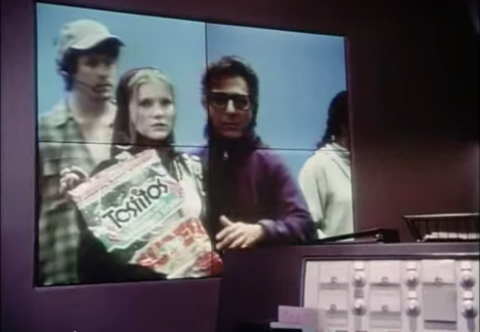Wag The Dog – Russia Analysis part II
March 26, 2015 § 1 Comment

Screenshot from Barry Levinson’s “Wag The Dog” (1997) – how to market a phony war for ulterior political ends
As discussed in the previous post, I opine that Russia – however menacing it may appear – is currently unable to prosecute considerable military might in more than one direction at a time.
This idea is elaborated on by the Swedish Defence Research Agency (FOI) in a paper published in April 2014 wherein the disposition and capability of Russia’s armed forces is briefly reviewed. The report suggests that Russia might have some 10-12 manoeuvre brigades available for deployment outside their current assignments to Military Districts, equivalent to approximately 35-40,000 troops – representing roughly one third of the grand total available.
The troops mentioned in the FOI report, initially concentrated in the Rostov area as witnessed by numerous first-hand accounts, have since appeared in Ukraine, taking part in the September onslaught and Ilovaisk battle, in the Donetsk airport struggle and in the encirclement battle of Debaltseve. They have not appeared as one formidable force but have rather rotated in and out, in mixed battalion tactical groups (BTGs). Each such BTG number approximately 1,000-1,500 people, depending on its composition.
These numbers also tally with Phillip Karber’s assessment of 48 BTGs having rotated to Ukraine as of mid January 2015, with a further, unknown, number supposedly staffing the training grounds and logistical chain that feeds the fighting across the border. This however is, of course, altogether denied by Russia in various statements ranging from Vladimir Putin, Kremlin spokesman Valery Peskov and Konstantin Kosachev, head of the Russian Cooperation Agency, in the recent Brussels Forum. You should know whom to believe.
All of this leads up to one conclusion: Russia cannot provide very much more troops to Ukraine unless they are to be second-rate or conscript quality troops. The best cadre has been used up already and some of them are dead. Whatever remain in far-flung garrisons is under-strength, ill-equipped and/or insufficiently trained to appear in the front line.
Thus, when TASS and various Russian military sources in mid-February claimed that they held a considerable snap inspection involving 80,000 troops, 220 aircraft and 100+ ships to project military might in the Arctic, it is pertinent to ask if these numbers are real or mere fantasy.
The Russian claim of 80,000 troops is a figment of Kremlin’s imagination, useful only for one thing: deceit and intimidation.
With some 25,000-35,000 troops in Crimea, another 30,000-40,000 troops deployed to or near eastern Ukraine in three different staging areas, it seems virtually impossible for Russia to muster a qualified invasion force of yet another 80,000 troops from the bulk of its remaining manpower. It seems fair to say that these garrison troops are not ready for battle; they are not concentrated in space or time nor are they under unified command. I would go so far as to say that the Russian claim of 80,000 troops is a figment of Kremlin’s imagination, useful only for one thing: deceit and intimidation.
The amount of alarm and hysteria produced by the Russian ”snap exercise” is considerable and plays straight into Russia’s intent: to make believe that Russia is militarily strong and capable of any aggression in any direction; to put the Fear of God into (primarily) the Baltic States including Poland, Finland and Sweden; to distract attention from Russia’s critical vector – Ukraine. If the West is more concerned about its own safety it will ignore and forget Ukraine’s plight: this is the real reasoning behind the Russian propaganda blitz and the recent snap inspection.
Recent jangling of nuclear threats – Putin’s carefully weighed admission that the use of nuclear arms was considered in the Crimean spectacle; deployment of Iskander missiles to Kaliningrad and Crimea; threats against Denmark; uncertainty whether Bear and Tu-22’s are actually packing nukes or not when they fly with inert transponders in international airspace – is also part and parcel of Kremlin’s ”new generation warfare” intimidation strategy. Suddenly everyone is running scared: what if an Air France Airbus collides with a Bear over Belgium – will that trigger a nuclear holocaust? This is what the Kremlin wants you to believe. This is how Kremlin works to cow the ill-informed and to give populist politicians ammunition for appeasement and continued disarmament.
While Russia IS undeniably a crazy scary rogue that has the oomph and inclination to project itself at will in virtually any direction, at least theoretically, all of this IS bluster, bluff and intimidation. Russia’s actions and behavior is not so much WAR, hot or cold, as it is a marketing campaign designed to give a certain impression. Simply put: don’t buy what Russia (and its agents) is selling: it’s a crooked brew that will leave you feeling sick forever.
Finally, I suggest that Western nations arm Ukraine and back it to the hilt, immediately and this very instance; that nations increase defence spending; join/support NATO and kick their anti-psyops teams into high gear. Russia has been playing us for fools for way too long already.
[…] two previous posts I opine that Russia is hard pressed to conclude its Ukrainian venture and wholly incapable of prosecuting war in more than one direction other than Ukraine. To go further Russia must drop the pretense of deniability and non-involvement […]